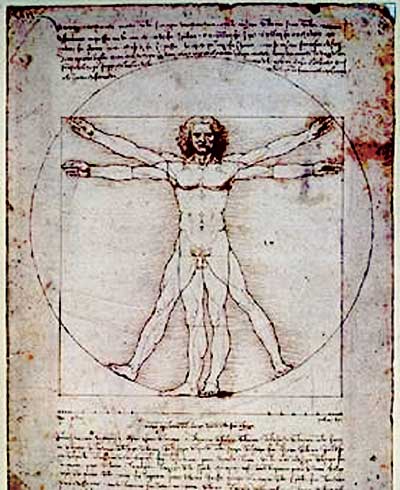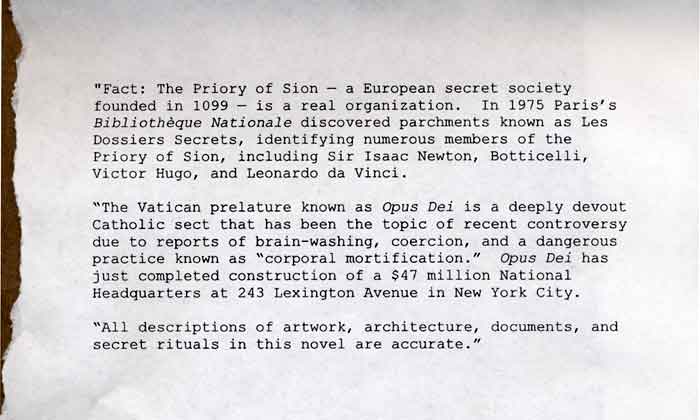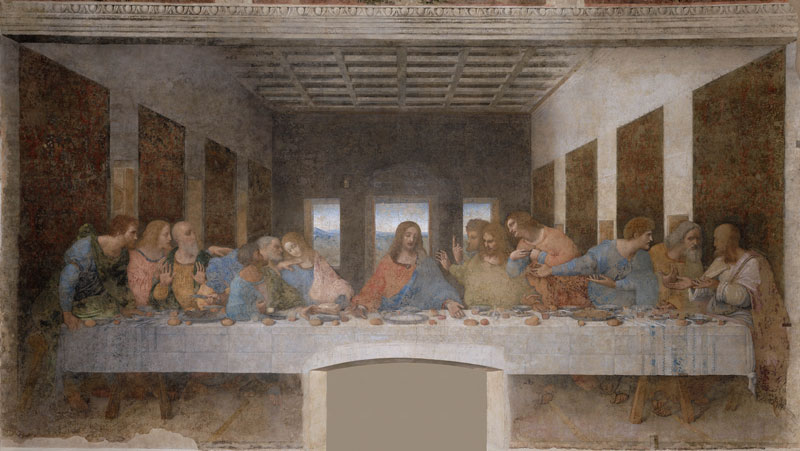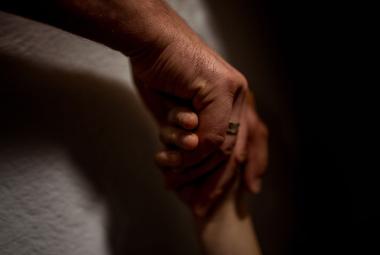We continue to get many questions which derive from the popular but shamefully blasphemous novel by Dan Brown, The Da Vinci Code. Despite the fact that it is a work of fiction, it has raised many troubling questions, especially among the less informed. Because of our widely distributed text, Cosmic Codes, many continue to turn to us for a response.1
We also understand that director Ron Howard is working on a major motion picture with Columbia on this subject, so the book will continue to be a popular topic of conversation. The Da Vinci Code has challenged many in their understanding of the Biblical texts and in dealing with some of the malicious heresies that have been twisted from a highly flawed view of the history - and related medieval legends that have sprung up through the centuries - surrounding the events described in the book.
The Plot
It is easy to see why this book made all the "Best Seller" lists. It's an engaging, fast-paced thriller with an exotic mix of secret societies, mysterious assassins, intrigues involving famous historical figures and controversial institutions, all linked together with a delicious series of secret codes and riddles to figure out. And behind it all emerges the most astonishing (and outrageous) "conspiracy theory" anyone could possibly imagine.
The story opens with the murder of the curator of Paris' most famous museum, during which he leaves enigmatic clues in the form of codes that our hero, Robert Langdon, an expert on occult symbology, and Sofie Neveu, a professional cryptologist who joins him, must solve.
 Several of these clues involve hidden messages among the sketches and paintings of Leonardo da Vinci, from which the novel gets its name.
Several of these clues involve hidden messages among the sketches and paintings of Leonardo da Vinci, from which the novel gets its name.
As it develops, our hero Langdon is being viewed as the prime suspect himself, and the urgency of solving the increasingly complex sequence of subsequent codes, riddles, and clues intensifies. The hidden agenda of a secret order behind the Knights Templar and the sinister intentions of committed operatives of Opus Dei, an official arm of the Roman Catholic Church, all weave a tapestry of intrigue and rapidly developing dangers.
It is quite a challenging ride. Short, engaging chapters - each unfolding a new mystery or plot twist - make this book virtually impossible to put down. (However, even after 105 chapters, the principal plot elements are not really resolved.)
Entertaining fiction has captured our imagination ever since Homer's epics, the Iliad and the Odyssey, so many centuries ago. In addition to challenging entertainment, a well-written historical novel is often an enjoyable sugarcoated way to experience a glimpse of history. However, that presumes that the thread of the fictional story is entwined within a tapestry of competent historical research.
The Problem
What makes any critique of Dan Brown's book particularly disturbing is his deliberate attempt to pass on the view that it is based on fact. The reader is immediately confronted with a preliminary page declaring certain parts of the book to be factual (see pic below): His last sentence on that page is, unfortunately, not true and is a major contributor to the confusion surrounding this shameful and blasphemous challenge for the uninitiated reader.

Beyond simply twisting history to suit his purposes and relying on falsified documents of disputed origins, Dan Brown's book raises thought-provoking questions about very real fundamental issues including:
- The reliability of the Bible.
- The true nature of Jesus Christ.
- The origin of Christian beliefs.
- The realities within the early church.
- The role of the "lost books of the Bible" and the many spurious heretical attempts to undermine the Gospels of the first century.
These issues are not incidental to the novel: they are central to its theme and constitute an intentional attack on Jesus Christ personally and on His church. This became particularly apparent during Dan Brown's public interviews in an ABC News Special and during his interview on Good Morning America. 2 His intentions were clearly deliberate and targeted.
Fortunately, Dan Brown's cleverly contrived romp has been brutally assaulted by numerous real facts and can only survive among the uninformed. The popularity of the novel, however, can open meaningful and constructive discussions regarding the foundations of the Christian faith and the reality of just who Jesus Christ really is. But, as always, one needs to be prepared.
The Underlying Premise
The fundamental theme lying behind (pun intended) the entire chain of events is the infamous Merovingian Heresy: that Jesus and Mary Magdalene had a child that ultimately resulted in the bloodline of the Merovingian kings of medieval France and which still continues behind the intrigues throughout the Europe of today.
Much of this was adapted from a book by Michael Baigent, Richard Leigh and Henry Lincoln, Holy Blood, Holy Grail , published in 1982. (The name of one of the key "experts" in Brown's novel, Leigh Teabing, is an anagram involving Leigh and Baigent.)
The mysterious secrets surrounding the fabled search for the "Holy Grail," according to the "expert" explanations embedded in Brown's novel, were but coded references to this bloodline.
The Da Vinci Connection
As an example of the several da Vinci-related "codes" suggested in the novel, from which it gets its name, is the notion that in the famous painting, The Last Supper, the person seated to Christ's right is not John (as is commonly assumed) but a woman! And this, of course, and other features are contrived to support the elevation of Mary Magdalene as His consort and "right hand." The Mona Lisa and the Madonna on the Rocks also participate in Brown's contrived twists to support his tale.

The novel doesn't limit itself to classical art objects alone: there are several "cryptexes,"3 the use of Hebrew atbash codes,4 and assorted riddles and anagrams, etc. One cannot deny the clever exploitation of these intriguing plot devices to carry the reader along.
But despite these colorful devices, and although the numerous scholastic rebuttals easily shred the many twisted and contrived allusions that are fostered to support Brown's engaging tale, serious foundational issues remain to unsettle any thoughtful reader.
Some Questions Raised
- Who was Mary Magdalene? How do we know that Jesus wasn't married?
- Why do we rely on the four Gospels and reject others? How and why were they chosen?
- What were the Gnostic Gospels and why were they - and the "lost books of the Bible" - rejected?
- Was there an editorial conspiracy within the early church?
- Does the Priory of Sion really exist? What is its agenda?
- Is there a "Merovingian" agenda behind the "New Europe"?
We will continue this review in our next issue and will also highlight the ultimate "code" that remains hidden behind the novel, The Da Vinci Code .
Notes:
- See Koinonia Institute for info on available courses.
- November 3, 2003.
- Cryptographic containers which self-destruct if not opened properly.
- See Cosmic Codes, page 48-49, for discussion.


